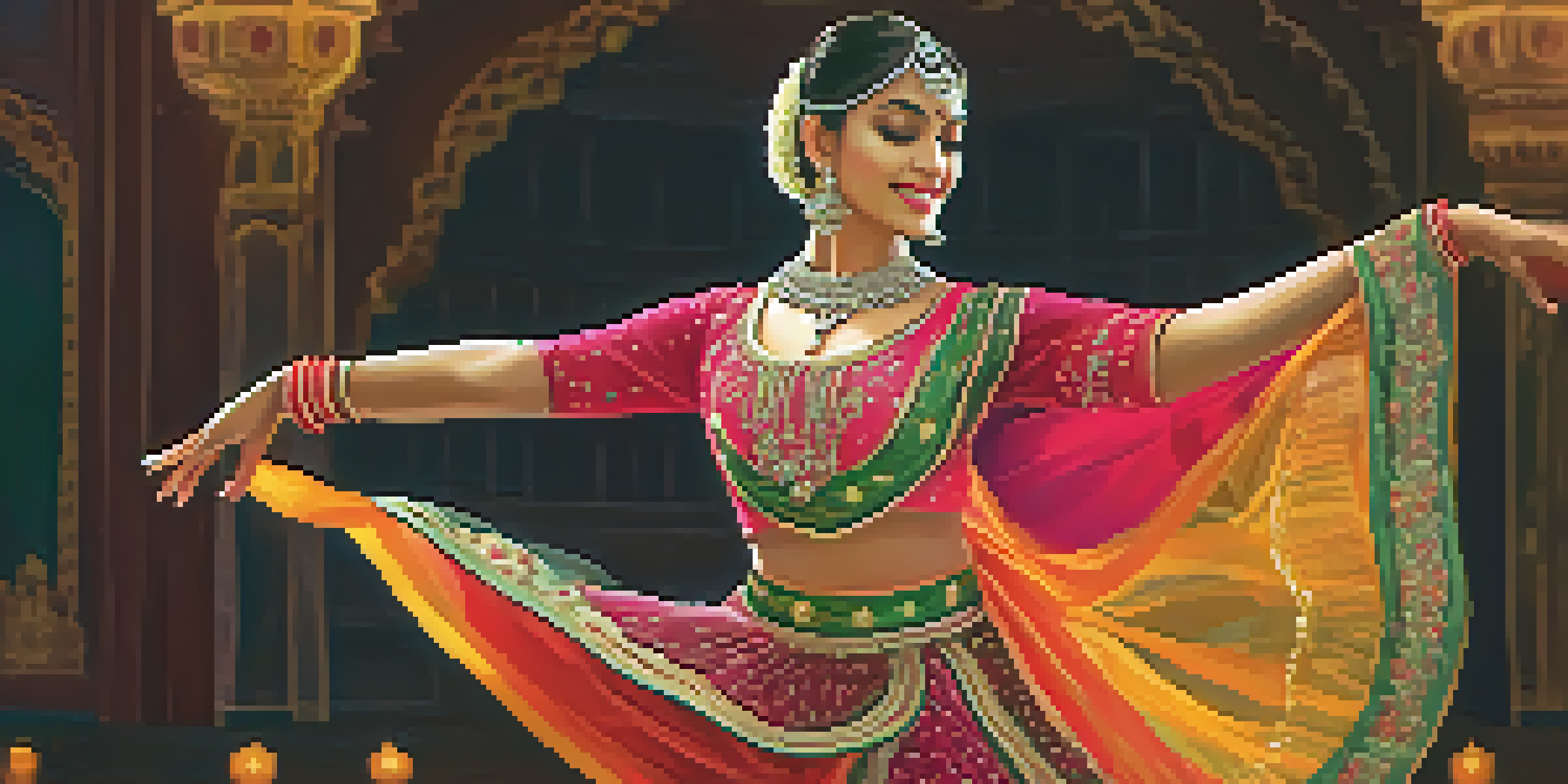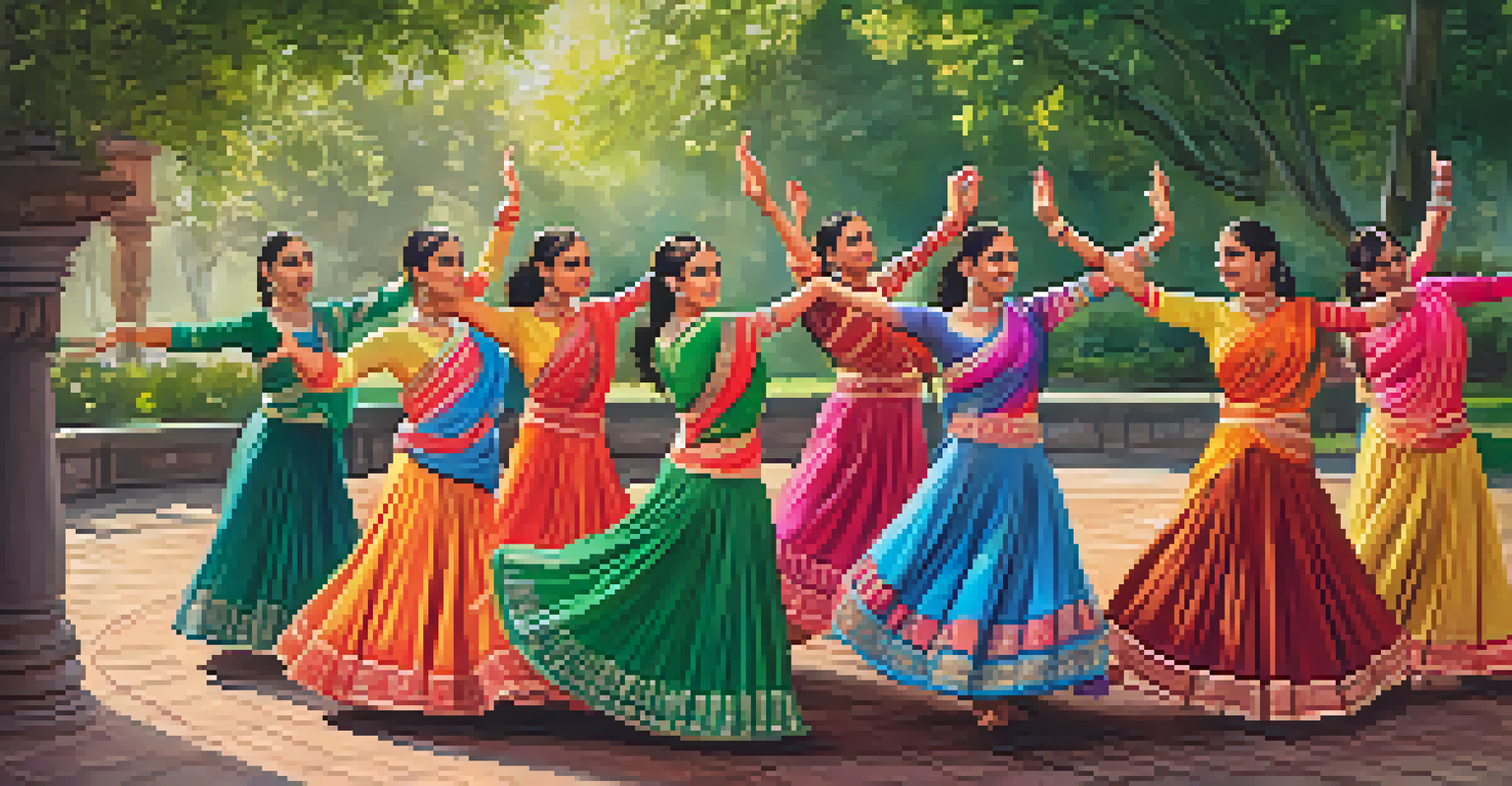Understanding Kathak: Traditional Dance and Its Modern Resurgence

The Origins of Kathak: A Journey Through Time
Kathak, one of the eight classical dance forms of India, has roots that trace back to ancient temples and the courts of kings. Historically, it began as a storytelling medium, where dancers narrated tales from Hindu epics like the Ramayana and Mahabharata. The word 'Kathak' itself derives from 'katha', meaning story, highlighting its narrative essence.
Dance is the hidden language of the soul.
As time progressed, Kathak evolved significantly, influenced by various cultural exchanges, particularly during the Mughal era. The dance form incorporated Persian and Mughal elements, merging traditional Indian styles with elaborate costumes and musical compositions. This blend not only enriched Kathak but also made it a prominent feature in royal courts.
Today, understanding Kathak involves recognizing its duality: it is both a spiritual and an artistic expression. While it retains its classical roots, the modern adaptations of Kathak continue to showcase its versatility. This rich history sets the stage for its resurgence in contemporary times, captivating new audiences.
Fundamentals of Kathak: Techniques and Styles
At its core, Kathak is characterized by intricate footwork, expressive hand gestures (mudras), and facial expressions that convey a spectrum of emotions. Dancers often perform to the rhythm of the tabla, using their feet to create intricate patterns on the ground. This rhythmic footwork, known as 'tatkar', is a hallmark of the dance form.

There are three main styles of Kathak: the Lucknow, Jaipur, and Banaras styles, each distinguished by their unique techniques and aesthetic qualities. The Lucknow style is known for its grace and storytelling, while the Jaipur style emphasizes vigorous footwork and energetic movements. The Banaras style, on the other hand, incorporates elements of spirituality, focusing on the devotion of the dancer.
Kathak's Rich Cultural Heritage
Kathak reflects India's diverse cultural identity, intertwining storytelling and historical narratives through its expressive dance.
Understanding these techniques and styles is essential for appreciating the depth of Kathak. Each performance is not just a display of skill but a narrative journey that invites audiences to experience the emotions and stories being portrayed. This blend of technique and storytelling is what makes Kathak so compelling.
The Cultural Significance of Kathak in India
Kathak serves as a mirror reflecting India's rich cultural heritage and evolving identity. It has been a medium for conveying religious themes, social messages, and historical tales, making it an essential part of Indian culture. This dance form not only entertains but also educates audiences about their history and values.
The dance is a poem of which each movement is a word.
Moreover, Kathak plays a crucial role in fostering community bonds and preserving traditions. Dance schools and cultural festivals often bring together people from various backgrounds, promoting unity through shared experiences. This communal aspect highlights how Kathak transcends beyond mere performance, becoming a celebration of culture.
In recent years, Kathak has gained recognition on global platforms, showcasing its significance beyond India's borders. With international performances and collaborations, this dance form is fostering cross-cultural dialogues, allowing others to appreciate its beauty and depth. This cultural significance continues to fuel its resurgence today.
The Role of Music in Kathak: A Harmonious Blend
Music is integral to Kathak, providing the emotional backdrop that enhances the dance. Traditionally performed with live musicians, the interplay between the dancer and the musicians creates a dynamic artistic experience. The rhythms of the tabla and the melodies of classical instruments like the sitar and harmonium are essential for setting the tone of the performance.
The structure of Kathak performances often includes various musical compositions, ranging from 'thumris' to 'dhrupads'. Each piece brings its unique flavor, allowing dancers to express different moods and themes. This musical diversity not only enriches the performance but also showcases the versatility of Kathak as an art form.
Modern Adaptations of Kathak
Contemporary interpretations of Kathak are merging traditional techniques with modern themes, making it relevant and relatable to today's audiences.
As contemporary interpretations of Kathak emerge, musicians are experimenting with fusion genres, incorporating modern instruments and styles. This blending of traditional and contemporary music is attracting younger audiences, ensuring that Kathak remains relevant in today's musical landscape. This evolution underscores how music and dance together create a captivating narrative.
Modern Adaptations: Kathak's Contemporary Evolution
In recent years, Kathak has witnessed a fascinating resurgence, adapting to modern sensibilities while preserving its core essence. Many contemporary choreographers are exploring innovative themes, incorporating current social issues into their performances. This evolution allows Kathak to resonate with today’s audiences, making it more relatable.
Additionally, the fusion of Kathak with other dance forms and styles has opened new avenues for creative expression. Collaborations with ballet, hip-hop, and even contemporary dance have resulted in unique performances that challenge traditional boundaries. These adaptations not only broaden the appeal of Kathak but also enrich its artistic vocabulary.
This modern resurgence reflects the dance form's resilience and ability to evolve while maintaining its authenticity. It is exciting to witness how Kathak is being reinterpreted, ensuring that it continues to thrive and inspire future generations. This adaptability is what keeps the spirit of Kathak alive in an ever-changing world.
The Impact of Technology on Kathak's Revival
Technology has played a significant role in the revival and popularization of Kathak in recent years. With the advent of social media platforms, dancers can share their performances with a global audience, breaking geographical barriers. This exposure has led to a renewed interest in Kathak, attracting new practitioners and enthusiasts.
Online classes and virtual performances have also become increasingly popular, allowing students from around the world to learn Kathak from esteemed teachers. This accessibility is crucial for keeping the dance form alive, as it nurtures a new generation of dancers who can explore its intricacies from the comfort of their homes. The digital age has truly democratized learning and appreciation of this art form.
Technology's Role in Kathak's Revival
The rise of digital platforms has facilitated the global sharing and learning of Kathak, attracting new enthusiasts and ensuring the art form's continuity.
Moreover, technology allows for innovative choreography and multimedia performances, blending visual effects with traditional dance. These creative explorations captivate audiences, presenting Kathak in fresh and exciting ways. As technology continues to evolve, it will undoubtedly shape the future of Kathak, enhancing its reach and relevance.
Celebrating the Future of Kathak: Opportunities Ahead
The future of Kathak appears bright, with various opportunities for growth and exploration. As more dancers embrace the art form, they bring their unique perspectives, enriching its narrative tapestry. This infusion of diverse voices and experiences is vital for keeping Kathak dynamic and relevant in contemporary society.
Moreover, increased global interest in Indian culture presents a unique opportunity for Kathak to shine on international stages. Cultural exchanges, workshops, and festivals are paving the way for cross-cultural collaborations, showcasing the beauty of Kathak to wider audiences. This exposure not only elevates the dance form but also enhances its status as a global art form.

As we celebrate the future of Kathak, it is essential to honor its rich traditions while embracing modern interpretations. By striking this balance, Kathak can continue to captivate hearts and minds, ensuring its place in the cultural narrative for generations to come. The journey of Kathak is one of resilience, creativity, and endless possibilities.